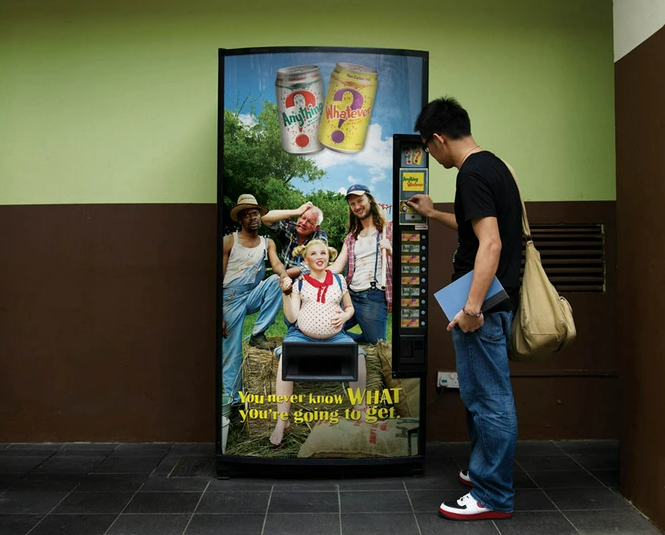Russian Roulette, Soda Style
In 2003, author Ben Schwartz wrote a book titled “The Paradox of Choice.” The main thesis of the book is that having more options isn’t necessarily a good thing — at some point, we feel overwhelmed, and making a decision becomes more difficult than it should be. For example, walk down the soda aisle of the grocery store and you may find dozens of different brands and flavors you can buy. If you went there looking for something sweet and bubbly to quench your thirst, but didn’t have a specific product in mind, there’s a good chance you’ll be overwhelmed by the number of options and end up buying nothing — even though anything would have sufficed.
The literal solution? “Anything.” Or, “Whatever,” as seen below.

The image above is a vending machine from Singapore from around 2007 — the exact date is unclear. The suggestive artwork featured a picture of three confused people and a purposefully positioned pregnant woman, as you can see, with the text “you never know WHAT you’re going to get.” And that was the whole idea. If you look carefully at the buttons on the vending machine, there are only two different ones, which alternate as you go down the column.
The two buttons were labeled “Anything” and “Whatever” — flavored drinks, one carbonated and one non-carbonated. On the carbonated side, there were six flavors: cola, cola with lemon, apple, root beer, a carbonated lemonade, and something akin to Sprite. If you hit an Anything button, you’d get one of those six — but you wouldn’t know which until the can came out from the machine. The non-carbonated buttons — the “Whatever” choice — worked the same way, but instead gave you flavored iced teas — lemon, peach, green, white grape, apple, and chrysanthemum.
The idea of soda plus a surprise proved highly popular in Singapore, not because the drinks were tasty, but because the gimmick proved to be very fun. As one advertising blog summarized, the pre-launch campaign featured ads “with lines like ‘Anything can happen on May 18’’ [and] ‘Get ready for whatever on May 18’” without any indication as to what “Anything and Whatever” were. Following the questionable taste seen in the vending machine creative, the launch campaign led with “a pun on the words: a sultry woman saying, ‘I can easily be satisfied by anything.’” The TV ads further played on the obvious dad jokes created by the products’ names — one, seen here, features a store clerk who thinks he’s getting robbed due to the confusion the products’ names caused; another, here, leverages the same ambiguity to poke fun at an entitled next-of-kin waiting to hear what his dying father has bequeathed him. The creative marketing built a buzz — and demand — for the drinks, even though consumers never actually knew what they were specifically going to get. Their initial sales goal, per one Singaporean site, was 2 million cans sold during their debut month; they more than doubled that.
But Anything and Whatever also had its problems. The first problem, while minor, was definitely odd: mosquitos. One of the ad campaigns featured empty soda cans attached to bus stops, but as Channe News Asia reported, the empty cans collected rainwater, “becoming breeding grounds for mosquitoes.” Second, unless you were buying from a vending machine, you could rather easily determine the flavor you were buying — the ingredients list was a dead giveaway. But the biggest problem of all was that most of their flavors didn’t taste all that good. And when the whole gimmick centers on the fact that you get what you get, but you don’t get upset, that’s a dealbreaker for most consumers.
After the novelty of Anything and Whatever faded, the products disappeared. As of 2010, you can’t find anything anywhere and you’ll have to settle for whatever other options you can find — because Anything and Whatever have been discontinued, replaced by nothing whatsoever.
Bonus fact: In 2002, the makers of 7Up decided to take on Mountain Dew with their own spin on things — an upside-down version of 7Up. Named “dnL” because the 7Up logo looks like that when flipped upside down (see a bottle here), it really did reverse the drink. 7Up is a colorless drink in a green bottle; dnL was a green drink in a clear bottle. 7Up has no caffeine; dNL was caffeinated. 7Up is a “lemon-lime” drink; dnL was, ridiculously, marketed as a “lime-lemon” soda. Unfortunately for the 7Up company, the product felt more like a joke than a real product and it proved unpopular — it was discontinued by the end of 2005. (Those of us whose initials are “DNL” are thankful.)
From the Archives: Mice Cold Soda: You’d probably prefer Anything else. Or Whatever.
